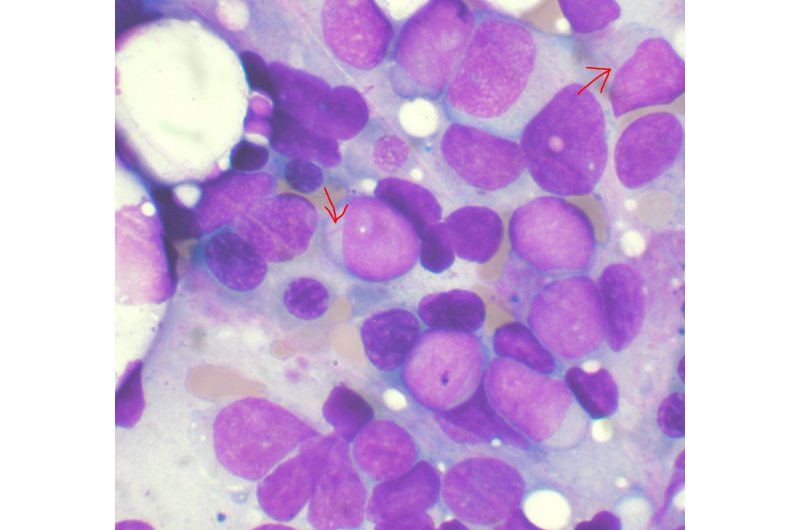Bone marrow aspirate showing acute myeloid leukemia. Several blasts have Auer rods. Credit: VashiDonsk/Wikipedia/CC BY-SA 3.0
Scientists have identified and modelled a distinct biology for paediatric acute myeloid leukaemia, one of the major causes of death in children.
The breakthrough research, from the University of Glasgow's Institute of Cancer Sciences and published in Nature Communications, significantly advances understanding of the disease and provides potential for developing specific treatment strategies for this childhood cancer, which is currently treated with therapies extrapolated from adult practice.
Acute myeloid leukaemia (AML) is one of the most aggressive types of blood cancer that affects children and adults of all ages and has the worst survival rates of all the leukaemias; and for children with AML, relapse is often fatal.
The researchers modelled AML in mice and demonstrated that AML is different in young cells compared to older cells. By analysing human paediatric AML samples, they discovered a 'gene signature' which highlighted immune system pathways significant.
Previously it was accepted that features of AML within the bone marrow apply to all AMLs, both paediatric and adult. Instead, the researchers found that the age of the original cell that becomes a leukaemia cell majorly impacts the nature of the disease that develops; young cells give rise to acute leukaemia with unique blood cell features and changes to the bone marrow environment that are distinct to the disease in adults.
Dr. Karen Keeshan from the University's Paul O'Gorman Leukaemia Research Centre, said: "Our findings are important because we have identified and modelled a distinct biology for paediatric AML. We show that, in fact, the disease in children is distinct from the disease in adults.
"Historically children with AML have received treatment based on adult practice, and we need better treatments specifically for children with AML.
"Our work has identified a distinct paediatric gene profile and paediatric gene targets; and by identifying targetable features of the disease in children, we can pursue new and better strategies to treat paediatric AML."
Brenda Gibson, Honorary Professor Paediatric Haematology and consultant at Glasgow's Royal Hospital for Children, said: "AML is a rare disease in children, and treatment has not been specific to children, but has been extrapolated from adult treatments with children treated as young adults.
"Despite giving children with AML the most intensive chemotherapy, a third of children still relapse; and when children with AML relapse, it is often fatal. In addition to a significant relapse rate, chemotherapy comes with a mortality rate from the treatment alone and also carries the risk of serious side effects which may affect children for the rest of their life.
"Dr. Keeshan's work is important because, by identifying differences in the biology of child and adult AML, we can hopefully identify targeted treatments that may not just improve outcomes, but importantly may be associated with fewer side effects than intensive chemotherapy; and as a result the survivors may have a better quality of life, which is very important for children with AML."
The incidence of AML increases with age, and in childhood accounts for 20 percent of all leukaemias. The current overall survival rate in children is only 60-75 percent, and thereafter falls progressively with age to 5-15 percent in the elderly. Both children and adults die from a combination of relapse and treatment-related mortality (up to 35 percent and 99 percent respectively).
The paper, "Age-specific biological and molecular profiling distinguishes paediatric from adult acute myeloid leukaemias' is published in Nature Communications.
More information: Shahzya Chaudhury et al. Age-specific biological and molecular profiling distinguishes paediatric from adult acute myeloid leukaemias, Nature Communications (2018). DOI: 10.1038/s41467-018-07584-1
Journal information: Nature Communications
Provided by University of Glasgow





















